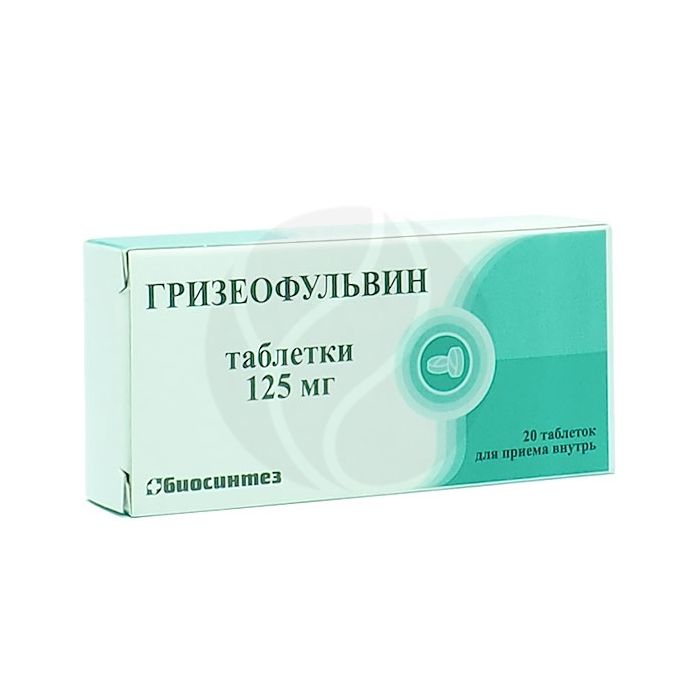Griseofulvin tablets 125mg, No. 20
Expiration Date: 05/2027
Russian Pharmacy name:
Гризеофульвин таблетки 125мг, №20
Dermatophytosis of the scalp, smooth skin and nails caused by fungi sensitive to the drug, including:
microsporia;
trichophytosis;
favus.
Epidermophytosis of the feet and hands caused by Trichophyton rubrum, Trichophyton interdigitale.
With microsporia, the daily dose for adults is up to 1000 mg (8 tablets), children are prescribed at the rate of 21-22 mg / kg of body weight / day. The drug should be taken daily until the first negative mycological analysis, and then taken in the same dose 2 weeks every other day and 2 weeks 2 times a week.
With onychomycosis, trichophytosis and favus of the scalp, the daily dose of the drug for adults weighing up to 50 kg is 625 mg (5 tab.), Then for every 10 kg of body weight the dose of the drug is increased by 125 mg (1 tab.). The maximum daily dose is 1 g (8 tab.)
With trichophytosis and favus for children, the drug is prescribed at the rate of 18 mg / kg of body weight / day. The course of treatment is carried out as with microsporia.
With onychomycosis for children and adolescents, the drug is prescribed at the rate of 16 mg / kg of body weight.
With onychomycosis, the drug is prescribed daily for the first month, every other day for the second month, then 2 times a week until the nail is completely replaced with a healthy one. The total duration of treatment should be at least 8 months.
The tablets should be taken with a meal with vegetable oil (1 teaspoon).
Tablets are white with a creamy shade, bitter taste, odorless.
1 tab.
griseofulvin 125 mg
Liver dysfunction;
impaired renal function;
changes in the morphological composition of the blood;
porphyria;
malignant tumors;
uterine bleeding;
systemic lupus erythematosus;
violation of cerebral circulation (including history);
pregnancy;
lactation period;
hypersensitivity to griseofulvin.
pharmachologic effect
Antifungal antibiotic. Has fungistatic effect. It is active against dermatophytes of the genera Trichophyton, Microsporum, Epidermophyton. Inhibits cell division of fungal cells in metaphase, disrupting the structure of the mitotic spindle. Griseofulvin accumulates to varying degrees in the cells of the skin, hair and nails, which are the precursors of keratin, making keratin resistant to fungal invasion. As the infected keratin separates, it is replaced with healthy tissue.
Side effect
From the digestive system: dyspepsia.
From the side of the central nervous system: headache, dizziness, disorientation.
From the hematopoietic system: leukopenia; rarely leukocytosis, eosinophilia.
Allergic reactions: urticaria, skin rash.
Application during pregnancy and lactation
Griseofulvin is contraindicated for use during pregnancy and lactation.
Application for violations of liver function
Contraindicated in liver dysfunction.
Application for impaired renal function
Contraindicated in cases of impaired renal function.
special instructions
When using Griseofulvin, it is necessary to control the morphological composition of the blood once every 10-15 days.
If allergic reactions occur, antiallergic therapy should be prescribed. With an increase in the severity of manifestations of allergic reactions, the drug should be canceled for 3-4 days. After the disappearance of the manifestations, the drug should be prescribed again, starting with 1/2 tab. / Day and gradually over 3-4 days, increasing it to therapeutic.
In the process of treating dermatophytosis of the scalp, it is necessary to shave off your hair weekly and wash your hair with warm water and soap 2 times a week. Treatment with Griseofulvin should be combined with the external use of antifungal drugs.
In case of onychomycosis, it is recommended to combine the use of Griseofulvin with the removal of the affected nails using keratolytic patches and local antifungal therapy.
Use in pediatrics
Children together with Griseofulvin are recommended to prescribe multivitamins.
Influence on the ability to drive vehicles and mechanisms
Patients taking Griseofulvin should refrain from engaging in potentially hazardous activities that require increased attention and speed of psychomotor reactions.

